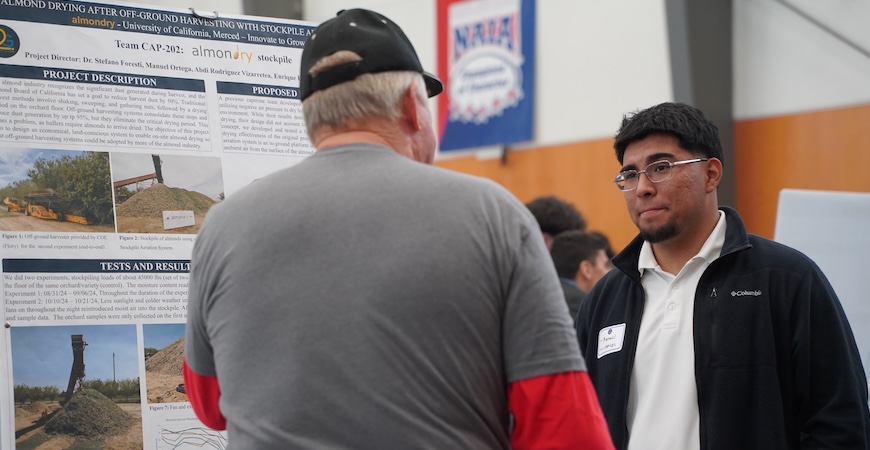
Helping diplomats navigate new cultures, removing mircroplastics from stormwater and automating raisin processing: These are some of the projects awarded winning scores at UC Merced's fall Innovate to Grow event.
Innovate to Grow, or I2G as it's known on campus, is a twice-a-year showcase for UC Merced engineering and computer science students to demonstrate projects they have been developing.
Teams of students work to address challenges presented to them by clients, then present their results to judges who are experts from around California.
The winning teams are as follows:
Lakireddy Engineering Award
Tater Techies
Working for client Arnold Farms of Atwater, team members David Hoehler, Hailey Romero, Morgan Phung, Shanald Lal and Xavier Walle redesigned an automatic seedling singulation and conveying system for planting sweet potatoes. Their system is designed to attach to a tractor, enhancing planting efficiency by minimizing skips and reducing labor costs.
Lakireddy Software Award
The Curators
Team members Fernando Martinez, Genesis Vazquez, Mark Araza and Psalm Bautista worked with client Globidea, a company whose mission is to make information easier to find and navigate. The team developed a browser extension designed for "curators" to transparently log content selected from any website and the respective hyperlink. The extension allows curators to select content and incorporate it into new digital works with the reference. To ensure curators always have up-to-date content, the extension periodically checks the sources for any changes. This team also won the data award for the Software Engineering Capstone.
Software Engineering Capstone
Food: Big Farma
Team members Garret Castro, Hans Guillen, Jason Yuen and Nick Mount designed an image capture system using AI-powered cameras to collect data on UC Merced's Experimental Smart Farm for client SupHerb. Then they used the data to engineer an algorithm to estimate the crop volume and linear regression to predict the harvest weight. With this system, SupHerb can automate and increase the accuracy of harvest weight estimation. Telit is supporting the project to then explore a broader agricultural market with their embedded AI capabilities.
Language: Ctrl+Alt+Schedule
Working for the U.S. Department of State Diplomacy Lab, Cheska Cinderella Friend, Quan Nguyen, Sergio Angulo and Tanner Jackson developed a centralized system platform tailored to the needs of the Language Learning Consultation Service.
The LCS, supported by the Diplomacy Lab, developed a centralized system platform, simplifying scheduling, improving accessibility and addressing issues such as high turnover. The team's solution condenses the entire process into just a few clicks, reducing inefficiencies and advancing LCS's mission to support diplomats in language training more effectively.
Civil and Environmental Engineering
Stormwater Saviors
Team members Julian Bowles-Baji, Juan Martinez-Aquino, Natalie Salinas and Christopher Rodriguez designed a bioretention cell that can be inserted into storm drains to filter out microplastics from roads on the UC Merced campus. The design structure uses stainless steel like that already used in storm drains to avoid using more plastics. Their research highlights the need for novel, cost-effective ways to address the issue of microplastics before they enter the stormwater system.
Engineering Capstone
Food Tech: Sun Maid Automation Solutions
Favour Nnaji, Kenneth Gampol, Luis Munguia Ruiz, Ricardo Barrera and Ricardo Bueno worked with client Sun-Maid, one of the largest raisin and dried fruit processors in the world. The team worked with plant engineers to automate a line, taking steps toward their goal of fully automating the facility. The line required a solution to replace the need for a human to straighten misaligned packages on the conveyor belt and remove defective bags. The team installed a guiding arm on the line to straighten misaligned bags as they move along the conveyor belt and implemented a computer vision camera connected to an air rejection system, which identifies defective bags and removes them from the conveyor for recycling.
Ag Tech: Almondry Stockpile
Abdi Rodriguez Vizarretea, Carlos Rodriguez, Enrique Estrada and Manuel Ortega were tasked with designing a reusable, land-conscious system to enable on-site almond drying aimed at helping reduce harvest dust. Building on a concept by a previous capstone team, the Almondry Stockpile team developed and tested a full-scale stockpile aeration system utilizing negative air pressure to pull ambient air from the surface of the almond stockpile. The team said its system can dry a stockpile equivalent to a set of hopper trailers (about 45,000 pounds) effectively, uniformly and faster than on the orchard floor. Cost of operation for the stockpile aeration system is minimal (less than half a cent per pound).
Precision: Wine Wise Development
Working with Gallo Winery, Dan Fraser, Eriverto Jimenez, Efren Lizarraga, Jesus Acevedo and Jonathan Gonzalez were tasked with addressing alignment issues along the production line. Their project addressed this challenge by designing a modified driveshaft system tailored to the winery's needs. Inspired by the mechanics of an automotive driveshaft, the team's design allows for controlled deformation of the inner rod under stress, preventing complete line shutdowns. The improved driveshaft system will enhance production efficiency and contribute to cost savings by minimizing maintenance interventions and part replacements.

